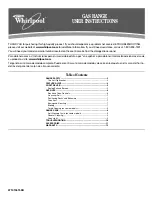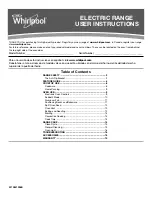
SECTION 4 -
CLEANING and MAINTENANCE
All surfaces are easier to clean if spillage is removed
before it becomes burnt on and if unit is cleaned daily.
Stainless Steel Surfaces
These surfaces should be cleaned with hot water and
detergent then dried and polished with a soft cloth.
Cleaning agents containing bleach, abrasives or caustic
chemicals will damage or stain the stainless steel
surfaces and must not be used.
Vitreous Enamel Surfaces
Approved cleaning agents which have the Vitreous
Enamel Development Centre
(VEDC)
mark are
recommended. it is advisable to clean daily after use.
Wipe vitreous enamel surfacesclean while they are still
warm using a soft cloth and hot soapy water.
Badly stained, removable parts should be soaked in hot
water with an approved detergent. Application of warm
water using nylon or scotch cleaning pads with such
detergent will give good results for non-removable parts.
Open Top Burners
Burner cleaning should be carried out daily.
Burner efficiency will be significantly reduced
if recommended cleaning is not carried out.
Remove pan supports and open top burner heads.
Wash all parts with hot soapy water according to detailed
instructions enclosed at end of section.
After washing, dry all parts well and ensure all water
is removed from inside burner head.
Wipe hob area. Hob tray may be lifted off for cleaning
purposes and is secured by ball stud fixings at each
corner. To lift away, pull tray up by gripping through burner
cut-outs.
Replace parts in reverse order. Ensure that all parts are
located correctly. The semi-sealed hob must be pushed
down fully on ball stud fixings.
Dry pan supports by hand.
NEVER LEAVE THESE TO DRY NATURALLY.
OVEN
To Clean The Oven
Clean while oven is warm but not hot. The enamelled
base plate lifts out and runners can be removed
(grip at bottom, lift up until lower exit brackets, pull toward
centre of oven and lower).
Oven
Temperature is automatically controlled by thermostat.
Caution
: Opening oven door will result in the escape of
heated air products. Care should be taken by users to
avoid being burned by any such action.
Grid Shelves
Two cooking shelves are supplied which can be
supported in any of five different positions within the oven.
When two shelves are used, these should be positioned
with at least one single shelf space between them.
Always push shelves in until stops hit the front of the
supports.
Tray Sizes
900mm wide oven will accomodate a 2/1 gastronorm tray.
600mm wide oven will accomodate a 1/1 gastronorm tray.
Single trays or dishes should be positioned centrally.
Trays must not be allowed to overhang the shelf in any
direction as this will adversely affect heat circulation.
Pre-Heat Time
Allow at least 45 minutes from lighting a cold oven before
a full load of food may be cooked. Air temperature will
have reached control setting in 15 minutes.
This pre-heat time may be suitable for lighter loads.
Insert food quickly and close doors firmly.
Oven Cooking Chart
This information is provided as guidance only. Figures are
approximate and based on a G3101 oven. Due to the
natural heat gradient in this type of oven, it will be
necessary to interchange products on upper and lower
shelves during cooking period.
Changeover timing varies according to product type,
weight and temperature.
80
1.1
230 2 & 4
10
16
80
4.5
240 2 & 4
9
14
36
2
200 2 & 4
12
20
48
3.6
230 2 & 4
10
17
12
8.2
195 2 & 4
35
60
72
2.7
240 3 & 5
18
32
4
5.5
200 2 & 4
12
24
72
26.5
220 2 & 4
70
110
T
otal
W
eight (kg)
T
emperature
Setting (°C)
Runner
Positions
Chageover
T
ime (mins)
T
otal Cook
T
imes (mins)
T
otal
Quantity
Vol-au-vents
(medium)
Sultana scones (½”)
Croissants (55g)
Quiche lorraine
(8” dia/680g)
Bread rolls (75g)
Yorkshire pudding
Sponge (slab)
Baked jacket
potatoes
Food
Products
























